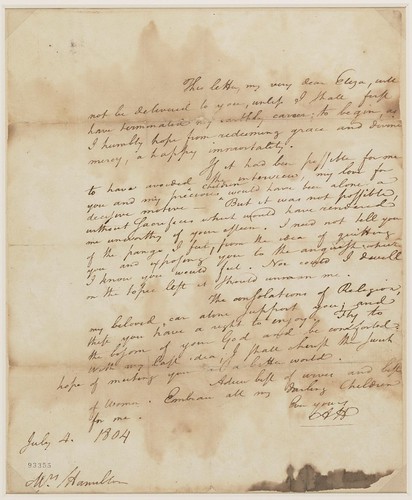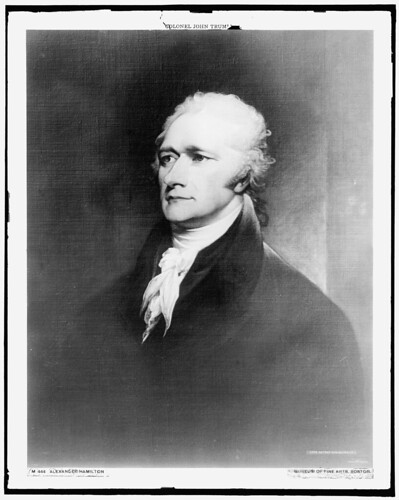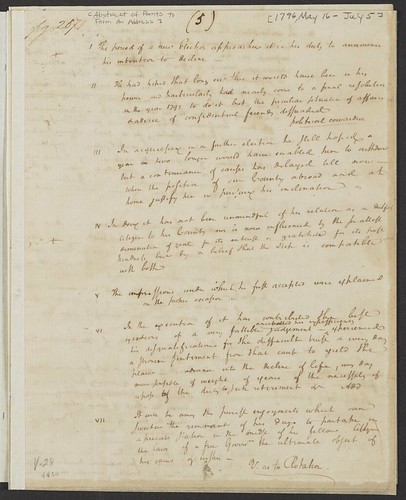The Library of Congress has put the papers of Alexander Hamilton online for the first time in their original format.

Alexander Hamilton, full-length portrait, standing, facing left, left hand on hip, right arm extended outward, books and papers beside him. Reproduction of painting by John Trumbull, Prints and Photographs Division.
The Library holds the world's largest collection of Hamilton papers—approximately 12,000 items concentrated from 1777 until Hamilton's death in 1804, including letters, legal papers and drafts of speeches and writings, among other items. Now, for the first time, these original documents—many in Hamilton's own hand—will be available for researchers, students or the generally curious anywhere in the world to explore, zoom in and read at loc.gov/collections/alexander-hamilton-papers.

Letter, Alexander Hamilton, then a 12-year-old clerk in St. Croix, to his friend Edward Stevens, November 11, 1769, noting he would "willingly risk my life tho' not my Character to exalt my Station." Alexander Hamilton Papers, Manuscript Division.
"The Library of Congress is home to millions of one-of-a-kind manuscripts that reveal America's history directly from the minds of the individuals who helped shape it," said Carla Hayden, Librarian of Congress. "Alexander Hamilton is certainly having his moment and I am so thrilled that people can learn more about him—actually read his descriptions of Revolutionary War battles, read letters to his wife, see the cross-outs in his draft of George Washington's farewell address and so many other things. Sharing this history is what the Library is all about."

Letter, Angelica Schuyler Church to her brother-in-law Alexander Hamilton, February 4, 1790. Alexander Hamilton Papers, Manuscript Division.
Items in the collection include:
• A letter written when Hamilton was 12 or 13 to his friend Edward Stevens describing his wish to raise his station in life;
• The outline of Hamilton's speech at the Constitutional Convention;
• Hamilton's draft of George Washington's farewell address;
• His draft of the infamous Reynolds pamphlet;
• A letter to his wife, Eliza, written shortly before his fatal duel with Aaron Burr.
In addition, the Library recently acquired 55 items, previously privately held—mostly letters from Hamilton's powerful father-in-law, General Philip Schuyler, to him and his wife—that have also been digitized and made available for the first time. Most of these have never been published.

Letter, Alexander Hamilton to Elizabeth Schuyler Hamilton, July 4, 1804, written shortly before his duel with Aaron Burr. Alexander Hamilton Papers, Manuscript Division.
Congress appropriated $20,000 in 1848 to buy the papers of Alexander Hamilton from his family, including his widow, Elizabeth Schuyler Hamilton. The papers were originally housed at the U.S. Department of State and came to the Library in 1904, along with all the department's historical papers, at the direction of President Theodore Roosevelt.

Letter, copy, Alexander Hamilton to the Marquis de Lafayette, October 15, 1781, reporting a joint French and American attack on British forces at Yorktown, Virginia, including a list of the killed and wounded. Alexander Hamilton Papers, Manuscript Division.
The Library supplemented the collection over time with additional gifts and purchases. The papers cover almost every aspect of Hamilton's career and private life: growing up in St. Croix, as George Washington's aide-de-camp during the Revolutionary War, New York delegate to the Constitutional Convention of 1787, the first U.S. treasury secretary, New York lawyer, and more.

Alexander Hamilton. Reproduction of painting by John Trumbull, Prints and Photographs Division.
The papers also include correspondence with and among members of his family, including his wife Elizabeth Schuyler Hamilton, his sister-in-law Angelica Schuyler Church, and his father-in-law Philip Schuyler.
The Hamilton Papers are among collections newly available online during the past year. Others include the papers of U.S. Presidents Millard Fillmore, Franklin Pierce and William Henry Harrison; the papers of Sigmund Freud; a collection of more than 4,600 newspapers from Japanese-American internment camps; a collection of web-based comic books; and 25,000 fire insurance maps from communities across America, the first installment of 500,000 that will be accessible online.

Alexander Hamilton, "Abstract of Points to Form and Address," May 16-July 5, 1796, for George Washington's September 1796 farewell speech. Alexander Hamilton Papers, Manuscript Division.
The Library of Congress is the world's largest library, offering access to the creative record of the United States—and extensive materials from around the world—both on-site and online. It is the main research arm of the U.S. Congress and the home of the U.S. Copyright Office. Explore collections, reference services and other programs and plan a visit at loc.gov, access the official site for U.S. federal legislative information at congress.gov and register creative works of authorship at copyright.gov.
All information and photos contained herein courtesy and copyright Library of Congress.
